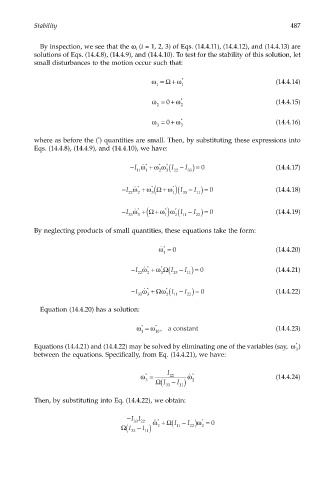Page 506 - Dynamics of Mechanical Systems
P. 506
0593_C14_fm Page 487 Tuesday, May 7, 2002 6:56 AM
Stability 487
By inspection, we see that the ω (i = 1, 2, 3) of Eqs. (14.4.11), (14.4.12), and (14.4.13) are
i
solutions of Eqs. (14.4.8), (14.4.9), and (14.4.10). To test for the stability of this solution, let
small disturbances to the motion occur such that:
ω = Ω + ω * (14.4.14)
1 1
ω =+ ω * (14.4.15)
0
2 2
ω =+ ω * (14.4.16)
0
3 3
where as before the ( ) quantities are small. Then, by substituting these expressions into
*
Eqs. (14.4.8), (14.4.9), and (14.4.10), we have:
−I ˙ ω * + ω ω * (I − ) = 0 (14.4.17)
*
I
11 1 2 3 22 33
ω
ω
−I ˙ ω * + (Ω + )(I − ) = 0 (14.4.18)
*
*
I
22 2 3 1 33 11
−I ˙ ω * +(Ω + ) (I − ) = 0 (14.4.19)
ω
ω
*
*
I
33 3 1 2 11 22
By neglecting products of small quantities, these equations take the form:
˙ ω = 0 (14.4.20)
*
1
−I ˙ ω * + ω Ω (I − ) = 0 (14.4.21)
*
I
22 2 3 33 11
−I ˙ ω * + ω * (I − ) = 0 (14.4.22)
Ω
I
33 3 2 11 22
Equation (14.4.20) has a solution:
ω = ω , a constant (14.4.23)
*
*
1 10
Equations (14.4.21) and (14.4.22) may be solved by eliminating one of the variables (say, ω * )
3
between the equations. Specifically, from Eq. (14.4.21), we have:
I
ω = 22 ω ˙ * (14.4.24)
*
3 Ω 33 (I − I 11) 2
Then, by substituting into Eq. (14.4.22), we obtain:
−II
Ω
33 22 ˙˙ ω * + (I − )ω * = 0
I
Ω (I 33 − ) 2 11 22 2
I
11

